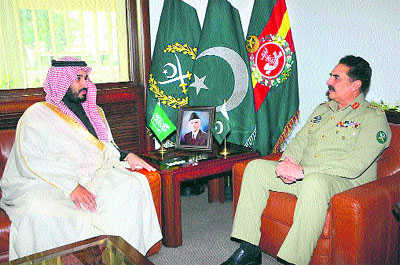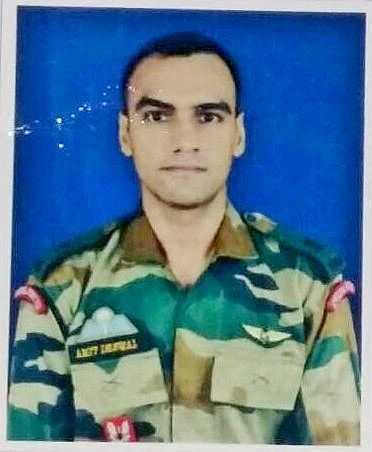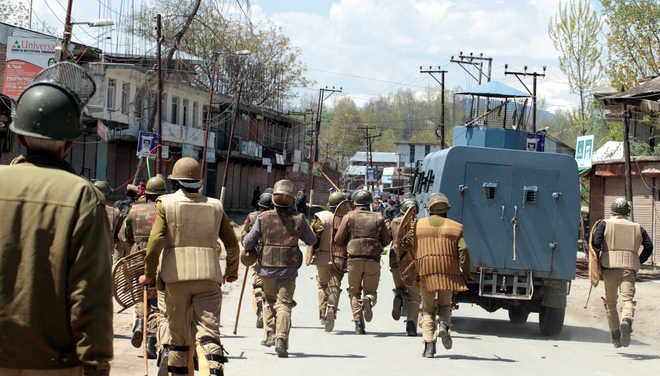G Parthasarathy
India shouldn’t have exaggerated expectations of any real breakthrough
 The Pakistan army regards itself as being above the law, disregarding even court notices.
The Pakistan army regards itself as being above the law, disregarding even court notices.PAKISTAN is one of the few countries today, which puts its defence minister in a virtual “purdah”. All those who deal with Pakistan, have heard of, or seen the ubiquitous Gen Raheel Sharif. Does anybody, however, know the name of the person who holds the high office of the defence minister in Pakistan? The peripatetic General Sharif is in Washington on one day, in Kabul on the next. He is also frequently travelling with Nawaz Sharif to countries like Saudi Arabia and Iran. When VIPS, including Afghan President Ashraf Ghani, or US Vice- President Joe Biden visit Pakistan, they visit the GHQ, to pay respects to the army chief. But defence minister Khwaja Asif, a Muslim League stalwart, is rarely seen or heard. Pakistan’s defence ministry hardly has the gumption or authority to turn down anything that the army chief based in the GHQ in Rawalpindi says or does. General Sharif has never been seen accompanying, meeting or talking to the hapless Khwaja Asif. He is only seen sitting opposite, or besides the Prime Minister, behaving like a co-equal of the Prime Minister. Even federal ministers and the Prime Minister’s brother and Chief Minister of Punjab, Shahbaz Sharif, have to seek permission to meet the regal General Sharif in his hallowed GHQ. The army regards itself as being above the law, disregarding notices from the Supreme Court on its operations in Baluchistan and undermining the court’s efforts to bring Musharraf to book for violating Pakistan’s constitution.Given this exalted role of the GHQ, one was surprised to recently read a widely publicised statement made to a parliamentary committee by Pakistan’s defence secretary. Incidentally, given their contempt for “bloody civilians”, the Pakistan army routinely insists that the defence secretary should be a retired army officer. Defence secretary Lt Gen Alam Khattak told the parliamentary committee on April 6 that India’s “infamous” R&AW had set up a “special cell” to sabotage the much-hyped “China-Pakistan Economic Corridor”, which the Pakistan army believes is the “magic wand” to solve all the country’s economic ills. General Khattak’s statement came the day after General Sharif said the same thing while blaming India for “destabilising” Pakistan. General Khattak added the usual “masala” to his statement by alleging that Indian consulates in Jalalabad, Kandahar and Mazar-e-Sharif in Afghanistan were working with that country’s National Directorate of Security (NDS), the Afghan counterpart of the ISI, by carrying out “subversive activities” in Baluchistan and the Pashtun tribal areas of Pakistan, bordering Afghanistan.Such allegations against India are not new. The recent addition has been the references to that “notorious” Indian “spy” Kulbhushan Jadhav, who was first said to have been arrested along the border with Afghanistan and was later claimed to have been arrested in Baluchistan. But here again, Pakistan finds itself in a bind. By denying India customary “consular access” to an arrested Indian national, statements made by Jadhav while under Pakistani custody will be seen to have been made under coercion. If Pakistan releases him, which seems unlikely for the present, Jadhav will sing a different tune and severely embarrass his captors with the many truths he will reveal. The Jadhav episode has also cast a shadow on Pakistan’s efforts to mend its strained relations with Iran. The bumptious General Sharif chose not to be present when Prime Minister Nawaz Sharif met visiting Iranian President Hassan Rouhani. With his customary swagger stick in his hand, he separately met President Rouhani the next day. The obedient army spokesman dutifully tweeted that his exalted boss had given “evidence” to the Iranian President about the evil Indians using Iranian soil to destabilise the Islamic Republic of Pakistan. An obviously irritated President Rouhani bristled with anger, when he was asked about this, noting that India, like Pakistan, was a friendly country. The Iranian embassy reiterated this a few days later.All this is occurring at a time when Pakistan’s relations with Afghanistan are going through a critical phase. With great difficulty and with significant help of Sirajuddin Haqqani, the head of the infamous Taliban linked Haqqani Network, the ISI has united a number of top Taliban leaders, including members of Mullah Omar’s family, with its handpicked protégé, Mullah Akhtar Mansour. The ISI calculation had been that with the Obama Administration beating a hasty retreat from Afghanistan, its Taliban protégés would take over, with China facilitating this process of transition. China obviously expects that a Pakistan-sponsored regime in Kabul would help it in eliminating the insurgency by its Muslim population in its neighbouring Xinjiang province. With the Taliban determined to seize control of more and more territory, one can expect heavy casualties in the ensuing months in Afghanistan. More so, as the China-US-Pakistan brokered peace talks, which are said to be “Afghan led” and “Afghan owned”, are going to be headed nowhere.Pakistan cannot remain unaffected by the conflict across the Durand Line. General Sharif’s operation Zarb-e-Azb in Pashtun tribal areas has resulted in nearly one million Pashtun tribesmen being uprooted from their homes, with bleak prospects of early return and rehabilitation. The Tehriq-e-Taliban, now operating from Afghan soil, has hit back, with attacks on institutions in Pakistan, linked to the Pakistani military. For the first time, the army is fighting its citizens in all four provinces of Pakistan. With Pashtuns comprising around one-fourth of the army, its generals will have to start looking at the reliability of its Pashtun soldiers. General Sharif has obviously learnt nothing from history. The only time Punjabi soldiers have prevailed over Pashtuns was under the command of a Sikh General, Hari Singh Nalwa, during the reign of Maharaja Ranjit Singh. Sadly for Pakistan, General Sharif does not have the attributes of military leadership of
Hari Singh Nalwa.
It is clear that the present dispensation in Pakistan has neither the imagination, nor foresight, to escape the inevitable consequences of its blunders in Afghanistan. Moreover, after the revelations of Nawaz Sharif’s family’s offshore accounts in Panama, Pakistan’s Prime Minister himself faces an uncertain future and tempestuous times ahead. While continuing a process of engagement with Pakistan, we should not have exaggerated expectations of any significant “breakthrough”. General Sharif should be left to stew in his own juice, along Pakistan’s western frontiers.
 All women officers completing seven years with the Indian Navy will now be eligible for permanent commission. The Navy was the only wing of the armed forces which had denied the permanent commission to women.
All women officers completing seven years with the Indian Navy will now be eligible for permanent commission. The Navy was the only wing of the armed forces which had denied the permanent commission to women.





































































